Similar Posts
Author’s Note: This article was written for a Moscow magazine on church aesthetics, and speaks to the situation with church art in parishes of the Russian Orthodox Church. In American churches, the situation is somewhat different. For example, icons and church utensils in America are not manufactured on the massive scale that occurs in Russia. So questions regarding the aesthetics of mass production are not so relevant for America. But the issue of aesthetics in general is extremely important – for any church, and most parishes, have big problems in that area. The questions surrounding aesthetics in churches are important because church arts (architecture, painting, and music) are, so to speak, the only part visible of the iceberg. They are what a person first sees and perceives when they come to the temple for the first time. And if this “first date” is uncomfortable or unsuccessful, a second date may not take place. Therefore, I hope that this article will be important and interesting for, not only the Russian, but American reader as well.
A few years ago, I had the chance to get to know Swiss church architecture, or rather several particular old churches. In general, there are many churches in Switzerland, they are well preserved and usually have their original appearance. Here, the restorations are carried out carefully, without the use of metal shingles or titanium nitride. I got a special aesthetic pleasure in Domat/Ems when I saw the Kapelle St. Antonius. This chapel stands on the top of a hill in the very center of the town and can be seen from anywhere. It has retained its appearance since the beginning of the 18th century. There is nothing special in its architecture, decoration, or design. Everything is more than simple: plastered and whitened walls, a wooden roof with a small dome, and only two icons in local Baroque style. Even excluding the outstanding examples of church architecture, in the neighboring villages there are many temples that are older, more original, and more artistic.
But it was near this modest little chapel that I clearly understood what most old churches have that most modern ones unfortunately lack. This is perhaps the most important quality for a work of art in general and for a work of church art in particular. If this quality is missing, then all paintings, icons, sculptures, and other pieces of church decoration, however beautiful, remain no more than a set of separate intrusive images and architectural elements. They can only interfere with the perception of something important and valuable in the church. But if this quality is present, then even the unpretentious architecture and painting fulfill their task, which is to lead a person to the meeting that should take place in the church.
I decided to call such a quality organicity.
I will try to give a definition below, but first it is important to understand what we are talking about.
For this, we need to talk about the antithesis of organicity, conducting a kind of proof by contradiction.
I called the antithesis “sham” (or “props” – like a prop at the theater – when on stage we see a cake made of plastic and a royal crown made of gold foil – they look a bit like the real thing, but in fact, they are fakes). We will start by discussing it, because it is not difficult to find it at all.
The sham is flourishing in modern church art. We can see its gardens (or jungles?) in almost every church and, for sure, in every church shop. Looking at the icons hanging all over such a shop, I catch myself thinking that I can understand the ancient iconoclasts. I am afraid even to imagine what is going on in the shop of the Sofrino plant![1] Fortunately, I have never been there. Silver-gilt icon cases, altars, and furniture; candlesticks, chandeliers, and lamps in the “candelabrum style” – our churches are full to the brim with all of this. Many square miles are covered with paintings, carvings, and gilding. The assembly line for icons produces them in frightening quantities. These mass-produced icons have already flooded literally all the churches and all the homes of pious Christians. But this is far from being just a Sofrino problem. Other workshops, studios, artists, architects, and craftsmen are keeping up with it. From the endless carved iconostases, one can build the Great Wall of China in any style, be it the 16th century, Baroque, Neoclassical, neo-Byzantine, pseudo-Russian, pseudo-neo-Byzantine, or neo-pseudo-Russian. There is no problem with the carving itself or with these styles. The problem is that most modern churches (leaving aside the few surviving historical ones) have nothing to do with these styles at all.
All this overabundance forms an image that resembles either the Terem Palace[2] or the fairytale City of Kitezh[3] from lacquered boxes. On the lid, one sees the domes and cupolas, the good fellows, and the rosy-cheeked lassies wearing kokoshniks. Then one opens the box and finds the gingerbread cookie inside. All of this is no longer simply sweet but syrupy and saccharine, signaling the quick approach of diabetes.
Who and at what point decided to make this gingerbread City of Kitezh the main style of church aesthetics?
I am not against the City of Kitezh or the pictures on laquered boxes. They represent folklore. But it isn’t entirely clear why such sugary images in the style of gingerbread surrealism became popular in mainstream church art. I am not against the Terem Palace; it was good for its time and its place. But that time has long gone, and the places are different, too. Then what is the reason for this love of ornamental and decorative frippery à la 17th century and multi-colored domes made of titanium nitride? Art is the language that the most gifted people of any generation use to speak with their contemporaries. This language must be natural (organic) so that contemporaries understand it. Otherwise, the message will not reach the audience. Whether people of future generations will understand it is also far from certain. Life and the aesthetics around us are completely different now. Then why do we resort to a non-existent and, in many ways, fictitious language to speak about the Truth in church art?
It was natural in the 1990s, during the church revival. Let’s make carvings as in the 16th century, because they are good carvings. Let’s make carvings in a classical style, because it is beautiful. Let’s make carvings à la Klim Mikhailov and Dorofey Zolotarev[4], because it is a tradition….
It was natural for church life in general at that time. Nobody knew anything about church life, and there was a feeling that if we simply imitated its traditional time-honored forms, then everything would work out by itself. And we began to imitate. We gave our churches the appearance of the Intercession on the Nerl.[5] We gave our icons the appearance of the works by Andrei Rublev. We gave our singing the appearance of the Znamenny chant. We gave ourselves the appearance of people living the life of the Church…
And it worked!
Churches of all possible types and styles have sprung up like mushrooms after rain. In each of them, there’s a full set of icons à la Rublev, Dionysius or Panselinos. At Christmas and Epiphany, these churches are crammed with Christian people. We have imitated the Intercession on Nerl, we have imitated Rublev, we have imitated prayer, and we have imitated Christian life itself.
Copying and imitation are the natural methods of any learning. But they are only methods. Reproduction of external forms is a way, but it is not a goal. But today, when counless churches are filled with thousands of images cloned with varying degrees of talent and external forms finally look like the old ones (or even better), there is a feeling that at some point the means became the goal.
The idea that this is only a stage, only a means, and that the next step needs to be taken is unpopular among the general religious public today. Only a few people have approached this. And only a few people have been able to take this next step, connecting Christianity with real life.
For most people, Christianity/Orthodoxy means a beautiful domed temple standing among the shabby nine-story buildings in a residential area. You open the door and find yourself in an amazing, shining world. This world has something in common with Hogwarts. Everywhere there are wonderful images and strange people in strange clothes, speaking and singing in a strange language. You walk around and you are deeply moved, looking at the silver-gilded icon cases in the candlelight. Then you sigh, close the door to this mysterious world, and return to your real life, to your usual flat in a nine-story building and your usual affairs. This reminds me of Uncle Julius from ‘Karlsson-on-the-Roof’ by Astrid Lindgren, who discovered the world of elves and gnomes. During the day, he is ill-humored, his teeth are false, his nephews are annoying, and his chicken tastes bad. But at night, he plunges into an unknown and fabulous world.
Coming to an Orthodox church, a person gets immersed in the world that is also largely a fairy tale. There are people in fairy tale armor, framed by ornaments à la Bilibin[6], there are fairy tale creatures, fairy tale City of Kitezh, fairy tale lives of fairy tale saints… Looking at all this, the word “lubok” often comes to mind.[7] Lubok depicts a reality that does not actually exist, but people really want it to exist. In this reality, everything is fine. There are good fellows, rosy-cheeked lassies, Bayun the Cat, and Sirin the Bird. Of course, it has little relation to the reality around us. Sometimes there is even a curious paradox: the more talented the artists are and the better they do their work (architecture, painting, singing, etc.), the deeper and wider is the gap separating this shining Hogwarts from the boring real life.
Moreover, this lubok has already grown to such a scale that one can exist quite comfortably within it. Crossing its boundaries and returning to the dull everyday life is no longer necessary. You go out shopping for a while, you meet the everyday life, and you go back to your dear lubok.
The sham started producing the sham to sustain its existence. A huge number of people live in this sham and make money off this sham. Yes, the production of sham has become a large and profitable business.
One might wonder what the issue is. Let people live in this fake lubok if they want; they do nothing wrong! But the situation is not as harmless as it may seem at first glance. The problem is that this lubok has grown so huge and is so firmly connected with the Church that today it has become a self-sufficient phenomenon and claims to be the Church itself. Thus, a person coming to the Church comes precisely to this Hogwarts and sees only this Hogwarts. It has completely obscured the modest Christian community with its silver-gilded, carved, titanium nitride grandeur. One needs a lot of effort to get through this jungle to what is hidden behind them. Many people remain in the world of elves and gnomes (or the City of Kitezh), believing that they are already in the Church.
This is not only a problem of church architecture and design. Architecture and design are only the tip of a giant iceberg of church life as a whole.
We will not analyze this life as a whole now, but let us focus on its visual and aesthetic side, being the most obvious one.
This aesthetic side is what a person coming to the Church encounters first. It is what one initially perceives the Church through. And sometimes, it is even the reason why one joins the Church.
Once I asked one American priest what was so important and significant for him that he left the Protestant Theological Faculty and became Orthodox. He answered, “Two things – the books of Father Alexander Schmemann and a small Orthodox chapel in the cemetery, which I passed on my way to the faculty.” The first one is obvious: Father Alexander can safely be called an apostle of the Orthodox Church in America, so strong is the influence of his books and sermons there. The second one is interesting. Services in this cemetery chapel were rare; it was usually closed. That student of the Theological Faculty would go to the windows and try to absorb and understand the unusual beauty that he managed to discern inside, looking through the glare on the glass. A little later the choice was made, and he became a priest and then the dean of an Orthodox Seminary.
The Seminary was lucky that the priests and artists of that small cemetery chapel paid such attention to the aesthetics. The Theological Faculty has no one to blame for not having paid such attention.
There is a counterargument saying that all church aesthetics – music, paintings, etc. – are there only for those who have recently joined the Church. These people are still weak and require the usual supports before they begin the true spiritual life. The life of the spirit is so different from the usual life that it does not have any usual forms at all. There is some reason in this. But it is necessary to note that without any aesthetic component at all, the meeting with spirituality can simply not happen. For some people, it may happen, but for others, most likely, it will not. If a person has already experienced a meeting with God, they do not care whether they hear any music or see any paintings; they know where they are going. But this can be said about very few members of the Church. For most people, this conscious meeting has not happened yet, and there is no guarantee that it will. The task of church art is to lead a person to this meeting or, at least, not to interfere with it. People who come to the church are very different. Some have perfect pitch, some have an IQ of 150, and some are aesthetically gifted. Each person’s talents are a way of understanding the world and channels through which the revelation may come. One receives it through the word, another through the harmony of sounds, and the third through artistic forms. If some of these channels are closed or missing, the Revelation may find other ways. But people who decorate the church and serve in it should not count on this.
Once, my colleagues and I were invited to an ancient church to complete the frescoes started by a local artist. The starosta (warden) said, “He’s done almost everything; only two walls remain. Will you take it on?” We looked it up and saw that the paintings were a complete disaster. Sometimes the work isn’t great, but it is still forgivable. But in that church it was absolutely dreadful, like a horror movie. We ask, “What does your rector think about the paintings? Is it okay for him?” The starosta answers, “Well, you see, our priest is visually challenged! He serves the liturgy mostly from memory, and he does not see at all what is on the vaults and the dome.”
If the parish consists of visually impaired and tone-deaf people, the task is simple. But if it is not so, those who form the appearance of the Orthodox Temple have a great responsibility.
For example, let’s imagine an aesthetically gifted young man walking through a park on a Sunday. He decides to heed the quiet inner call and enters an Orthodox church for the first time in his life. But the park is the Patriot Park near Moscow, and the church is the Main Cathedral of the Russian Armed Forces, built from some captured enemy cannons. It is far from certain that this aesthetically gifted young man will want to enter any other church in his life. It is quite probable that he will leave thinking, “If this is Orthodoxy, I definitely don’t need it.”
Of course, one can say to this young man, “Go wherever you want. We already have more than enough intellectuals like you. We don’t care about your aesthetic gifts.” Or, as we have already discussed, one can say that it is only the “undeveloped neophytes” who need the aesthetics. But the history of the Church shows us something else. There have been intense (sometimes even deadly) debates about icons and images from the earliest times. Then the Church firmly decided that images are necessary and important to it. Saint John of Damascus, Saint Theodore the Studite, and many other less well-known thinkers explained this need in detail. Since then, the Church has always affirmed the importance of the aesthetic side of its life. The celebration of the Triumph of Orthodoxy is not for nothing. We can say with confidence that aesthetics (and, in particular, visual aesthetics) are given great importance in the Church. Thus, we need to deal with aesthetics itself.
But why exactly is sham a bad thing? The answer is quite simple: because the sham is fake. A fake thing is what replaces and obscures something real and genuine.
For example, most modern churches use reinforced concrete structures. The builders make a reinforced concrete ceiling, and then they hang under it the fake plasterboard vaults à la Terem Palace. This is nothing but sham. But why is this done, then? There are many explanations: “Otherwise people won’t understand”, “We must be different from the Protestants”, “This is our way”, “This is an Orthodox tradition”, etcetera. This may seem harmless, but if we delve deeper, we reveal a gigantic forgery. It turns out that the Orthodox tradition is a Terem Palace! And if it is not the Terem Palace, it is no longer the Orthodoxy. We are in a dead-end with the sham and the lubok. The lubok says, “I am the Orthodox tradition!” And it is difficult to argue here. Indeed, the vaults, the onion domes, the carving, and the gilding are quite traditional. They are a standard set that every self-respecting Orthodox temple must present to the viewer. And if it does not present it, an attentive user should immediately be suspicious. Are they Protestants? Are they Renovationists?[8] Is this MODERNISM?!
In general, “modernism” is a spooky word that can be used to scare young architects and artists at night. Almost anything can be put under this concept. Thus, there’s no other choice but to stick as many onion domes on a new church as possible. Then everyone can breathe a sigh of relief and say, “No, this isn’t modernism!”
Of course, there’s no problem with the onion domes in themselves. But when they become the obligatory component of the sugary City of Kitezh, they cease to be harmless. They help to introduce the unprepared viewer into the illusory reality of this Kitezh. They begin to form the illusion, while the initial task of the Christian Church is the opposite. It is to lead people out of the illusory world and draw their attention to reality, turning it from the unworthy things, the “elves and gnomes”.
We can observe that quite a rather terrible thing has happened. The sham has become the norm. Today, this sham is perceived by most of our churchgoing people as the norm.
How to deal with this (and whether we should try to deal with it at all) is not a simple question. It is impossible to answer it within the framework of a short article.
But if the artists deem it necessary, they have every opportunity to oppose the manifestations of sham in the available space using available methods.
This brings us to the question of the organicity.
Why did I find a model of organicity in that Swiss chapel?
If we start to analyze this project, we can count at least three components: purpose, exterior, and interior. In this case, the interior includes paintings, furniture, and decoration. The chapel is truly ideal because all these components are in harmony with each other. They help each other; they arise from each other; they do not contradict each other or draw too much attention to themselves. All of these components in their original form are due to a natural necessity. Together they make up an inseparable whole.
This is a small rural church, designed for holiday services for a small number of parishioners. There will never be many people because the town is small and there are several churches in it. The architecture fits perfectly into the surrounding urban and natural environment. The place for the chapel is ideal. The functional and aesthetic tasks are so merged that it is difficult to separate one from the other. The interior is decorated exactly as the small church should look on the inside. There is not a single unnecessary detail, and there are only two visual accents – two icons in icon cases. The viewer’s attention concentrates on them immediately and entirely. There is no decorative show or empty “noise”.
The task was very clear, and it was solved by the simplest and most natural methods. Only the necessary visual techniques were used; there is nothing excessive. All components are in harmony with the whole and with each other.
The latter is especially important. Before, this was natural, but it is unclear how to achieve it today.
Up until the 19th century, the architects and artists were free from having to play with styles. They did not have to make a painful stylistic choice; everything came naturally. The aesthetics were inextricably linked with the functional part. It was difficult to determine where one thing ends and the other begins. For example, the arched structures and brickwork became an integral part of the aesthetics of many ancient churches.
The old artists worked in only one possible way; they couldn’t do it any other way. Today’s artist can easily ask, “Do you want the “academic” icon or the “canonical” one?”
Our artistic thinking is eclectic because it was formed in an eclectic way. We have inherited the work of all previous generations of architects, builders, and decorators. But to benefit from this wealth, a lot of effort has to be put in.
At the Belarusian Academy of Arts there is an anecdote about Mikhail Savitsky, the classic of the austere Soviet style. He told his students, “If you look at your work and think whether to do something or not, don’t do it! Do only what you can’t live without.”
Perhaps this advice can be the key to understanding the principles of church art today. Any individual architectural and artistic component of a project must arise from a natural necessity.
Before, this rule worked naturally. Today, it’s a disaster. A white-stone cathedral with domes, mosaics, and carvings can arise in the middle of a village of ten households. Why did it appear? It is because a sponsor-benefactor decided to build a church in his small home village. He can’t build a little booth, like those Swiss in the 18th century. He does solid work on a grand scale. And then, when this benefactor stops giving money, the church will close because the parish won’t be able to pay the bills. The parish will move to a small annex that will easily fit everyone on Sundays.
Let me give one more example of true organicity.
This is the Protection Church in Oreanda in Crimea.
The architect was lucky, as few others have been. To work with such source material is a true gift. The church stands on a steep slope of the southern coast of Crimea, among pine trees, with a view of the sea and the spit of land all the way to Yalta. Once I saw it on a hot summer day, when everything around was in bloom and there was a smell of pine needles and resin, warmed by the sun. I looked at the steep slope, the sea, and the flowers, and it seemed a true paradise on earth.
The architect also made the most of this opportunity. The church turned out to be human-scale and very comfortable inside. Mosaics from the best masters of that time are its highlight. But its main quality can only be appreciated during the liturgy. The side walls of this elongated church have several double doors. On a sunny day, during the liturgy, they stand open. The walls seem to dissolve, and the blooming Crimean nature, in all its splendor, is united with the interior space of the church. The man-created temple becomes part of the Temple made by the Creator Himself.
I was especially lucky to be there on Pentecost, when this feeling was strongest.
Here, too, everything is logical. This is a church for a small number of parishioners in a warm southern climate among blooming nature. Georgian and Armenian churches located in similar conditions were taken as models. But this project was adapted to specific conditions and a unique landscape. The decoration is minimalistic with an emphasis on beautiful mosaics located in the right places. The idea works perfectly. Not only do the details not contradict each other, but they merge into a true symphony.
Of course, this is a unique example, but we have many other examples that are not so unique but just as organic. The key point is that any detail of the project should have natural reasons and be connected to the main idea and to other details.
But if such a project were to appear somewhere closer to the Arctic Circle, it would lose all its organic nature. It may sound funny, but too often this is more or less what happens today. Yes, most people are practical enough not to build a church with open walls near the Arctic Circle. But when it comes to less practical things, this is usually the case. To borrow the project built at another time, by other people, in another place, for other purposes and by other means – this is our way!
For example, one priest of a small village parish near Minsk wanted an image of the Mother of God from the Hagia Sophia in Constantinople for the apse of his church. Why? Because he likes it. I like it too, but I tried to explain, “Father, look at Hagia Sophia and look at your church! There, the image was designed to be viewed from a hundred meters, and you have only seven! You don’t need that image, you need a different one. And even if we simply reduce the size of the image from Hagia Sophia, it will still be wrong, because everything is different here.”
Then I tried to use more accessible language: “Just imagine – a quiet evening prayer is going on in the skete church of a remote monastery. There is semi-darkness, the candles. One monk sings the Znamenny chant. And suddenly, in the middle of all this, the choir starts to sing the Bortniansky[9]. What do you think will happen?”
The priest ‘kills’ me with his answer: “Wow, great! That’s how it’s done!” Drop the mic.
However, most people understand musical analogies well enough. Rare parish choirs try to mix the Znamenny chant with Bortniansky. But when it comes to architecture and art, the tastes are less obvious.
Here’s another related example. After a conversation about the importance of an individual approach to church decoration, one of the listeners said, “Well, I like old icons more than modern ones – they are more beautiful”. I answered, “Yes, I prefer the old ones, too”. “But why are you talking about painted icons then? They won’t turn out better than old ones anyway. I’d better simply print out Dionysius and get real beauty!” And he looked pleased, with a ‘gotcha!’ look on his face.
Let’s return to music. Imagine a service in a village church, somewhere in the province. There’s a priest, ten parishioners, and the choir. The choir consists of local grannies. We all know how they sing. If any of them had a good voice in their youth, those times are long gone. And often their hearing is gone, too. Those who have heard can imagine the sound of their singing. At the same time, there’s the choir of the Trinity Lavra of Saint Sergius. This is simply the Triumph of Orthodoxy! Or let’s take the Choir of the Valaam Monastery. I remember when their first recordings appeared, people had tears in their eyes. A true feast of aesthetics! Today there is a lot of amazing church music for every taste. If you want prayerful concentration, here you go! If you want the Triumph of Orthodoxy, here it is! But no one would even think of comparing them with the choir of the village grannies! These are different worlds.
At the same time, no one would try to replace this feeble choir with a recording. But how simple it would be! One click and you have Valaam in your church! Another click, and you have Lavra!
But everyone understands that without those grannies, there will be no liturgy. Because the liturgy is a living thing. The recording, no matter how beautiful, is not a living thing. Because the liturgy is Life. It is also a spiritual experience. Personal experience and personal emotion. The experience of another person, even the one with perfect pitch and an operatic baritone, may not work for you or me. The liturgy deprived of personal experience and personal emotion is no longer a liturgy. It is an aesthetic exercise and nothing more.
It seems to be clear with singing. Why then is it not clear with painting? After all, it is all the same. An icon is the result of the personal spiritual experience of a particular icon painter. The result of his relationship with God and his knowledge of God is a living thing. This is because life itself is communication with God.
This experience can be much less vivid and convincing than that of Andrei Rublev. His contemporaries were luckier than us. But Rublev has already lived his life in the Church, and we are living our life.
This life is organicity itself. That’s why the choir of grannies is quite organic, despite its ambiguous aesthetics.
There is only one recipe to deal with such aesthetics – to choose the correct task. The grannies will not handle a chant written for a choir with forty sopranos. But they can always manage something simpler.
Kapelle St. Antonius is a small aesthetic miracle despite having no marble, no carved capitals, no gilding – almost nothing at all. But it does not lose any of its aesthetics. On the contrary, it gains a lot because it is organic. This is always linked with aesthetics. An attempt to achieve aesthetics without organicity would look like a gaudy gingerbread house (as it often looks today). The organicity without aesthetics is also a strange thing. It is the same as saying, “A manure basket is beautiful because it fulfills its function”. Poor aesthetically gifted young man!
But there is some hope for him, still.
After all, it may be that the church that he will eventually enter will be the Protection Church in Oreanda on Pentecost. Then the puzzle will come together. The phenomenon will no longer be divided into components. The unity of spiritual content and artistic form will manifest itself in the most natural way. There will be no need to talk about the “symbolism of color in the icon”. There will be no need to talk about symbolism at all; everything will become self-evident. For an aesthetically gifted young man, the perfection of the form of the Oreanda church would be a fairly good testimony to Divine Being in itself.
A person reads the aesthetics instantly and often subconsciously. Intellectual perception is different; it requires time and conscious effort. That is why the aesthetics are so important. Without them, the transition to the intellectual discussion may never happen.
Fortunately, today we can see a growing understanding of this importance and a desire to work with church aesthetics. But in general, there is still a lot of gingerbread surrealism. Gingerbread surrealism is, by definition, an artificial and illusory phenomenon. But for some reason we still consider it possible to talk about real and serious things in an invented gibberish language. In such a context, even one worthy example of organicity can hardly be overestimated.
I would venture to suggest that the Trinity by Rublev or the Virgin of Vladimir displayed at the Tretyakov Gallery converted more people than many church preachers combined.
Today we don’t create such striking works of art, but the work is going on, thank God.
So, go for it, young man!
[1] Sofrino – the center for mass-production of religious decoration.
[2] Terem Palace – richly decorated 17th century building in the Moscow Kremlin.
[3] City of Kitezh – legendary city gone underwater, a symbol for something lost.
[4] Klim Mikhailov and Dorofey Zolotarev – famous 17th century carvers who decorated the churches of Moscow Kremlin.
[5] Church of the Intercession on the Nerl – famous 12th century church in Vladimir region.
[6] Ivan Bilibin (1876-1942) – Russian artist and book illustrator.
[7] Lubok – traditional Russian popular woodcut print.
[8] Renovationism – a schism in the Orthodox Church in the USSR in the 1920s-1940s.
[9]Dmitry Bortniansky (1751-1825) – Imperial era Russian composer of church music.
Click here to visit the website of Anton and Ekaterina Daineko
If you enjoyed this article, please use the PayPal button below to donate to support the work of the Orthodox Arts Journal. The costs to maintain the website are considerable.

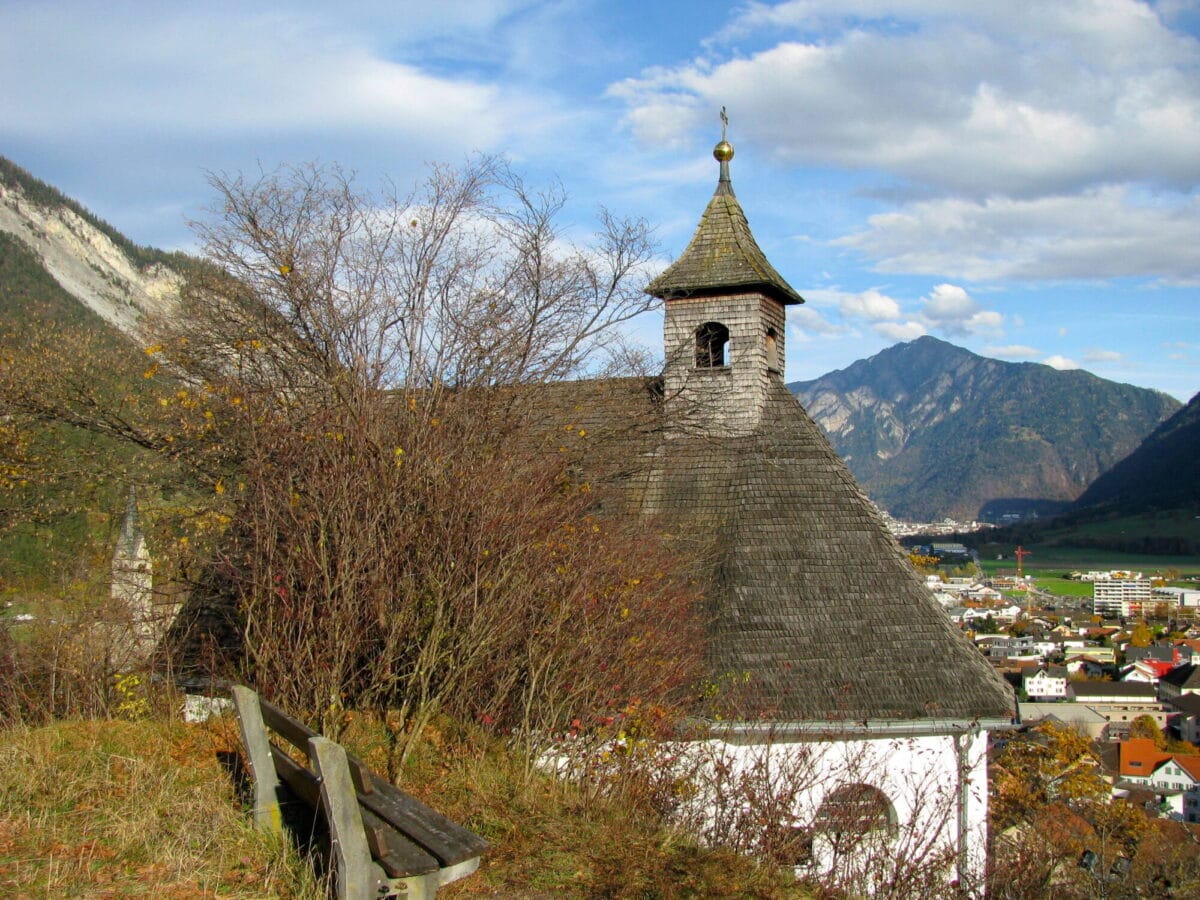
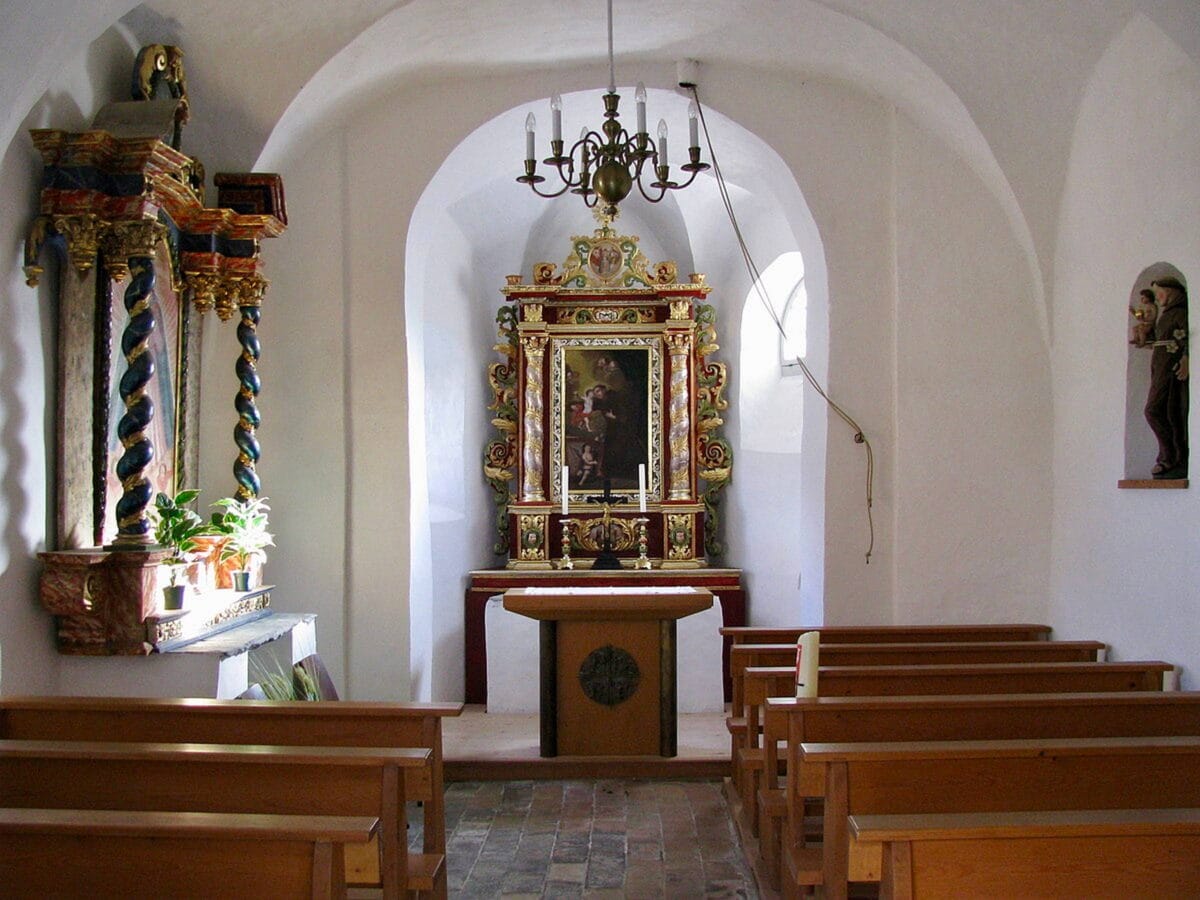
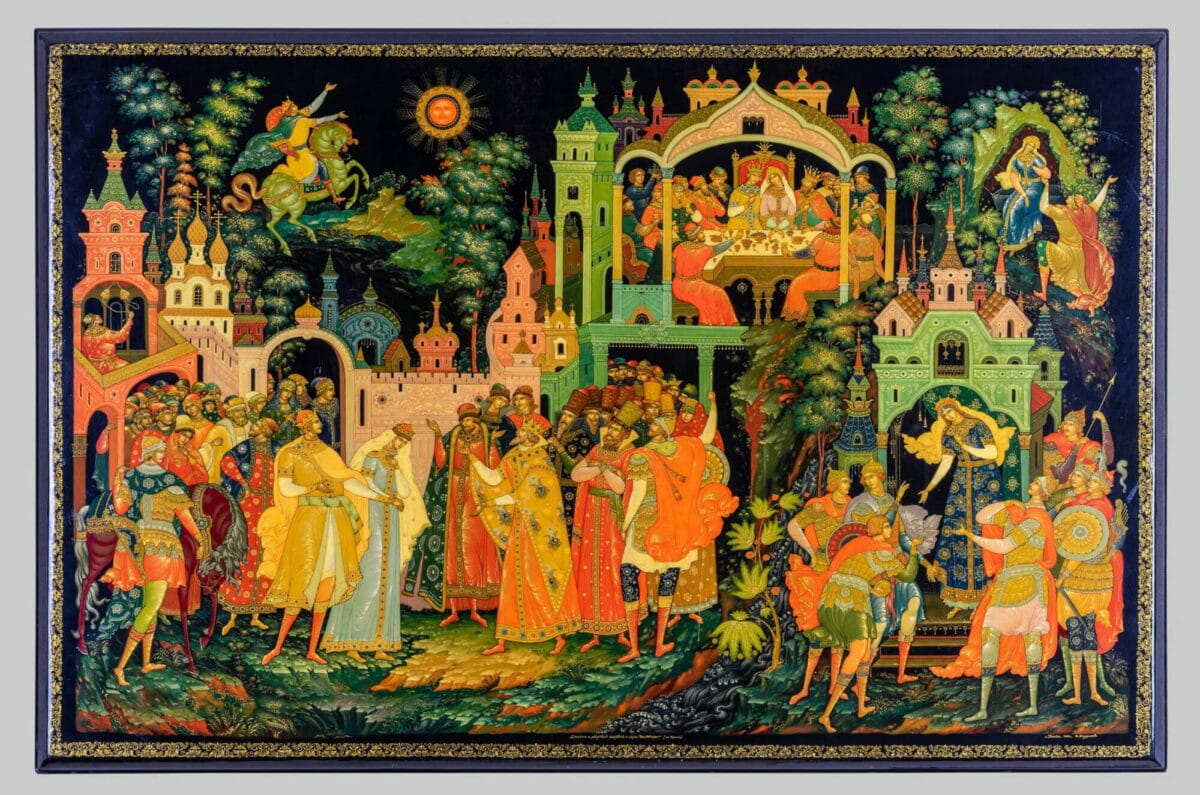
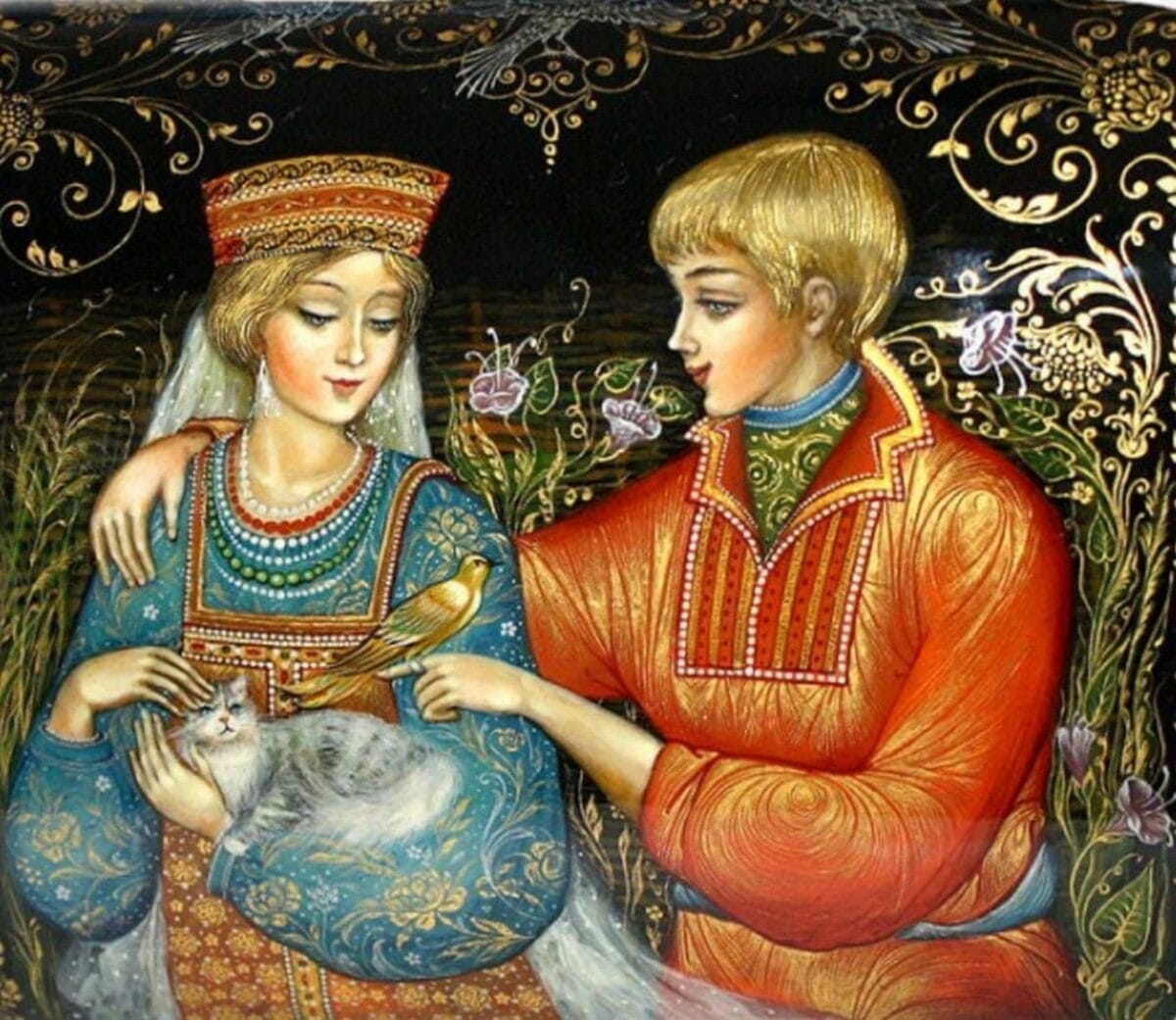
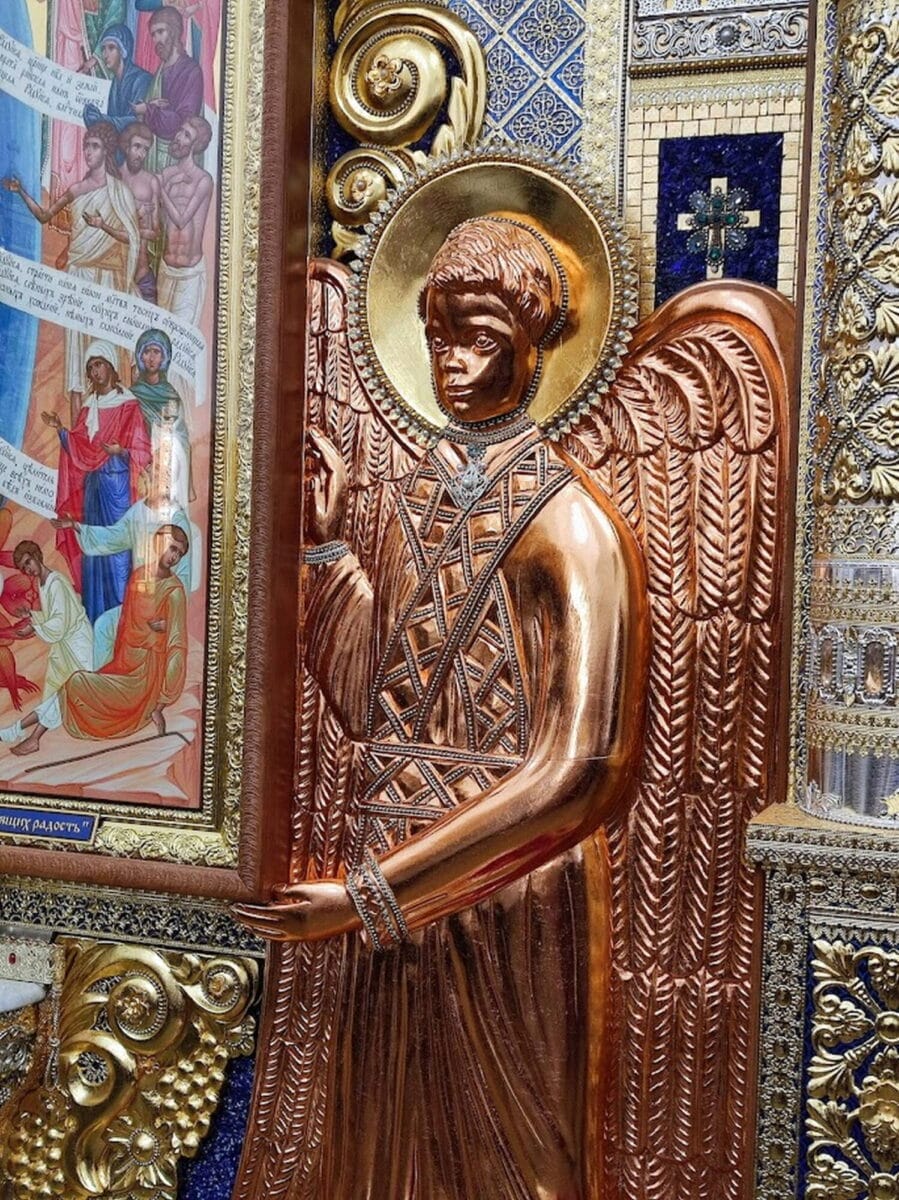
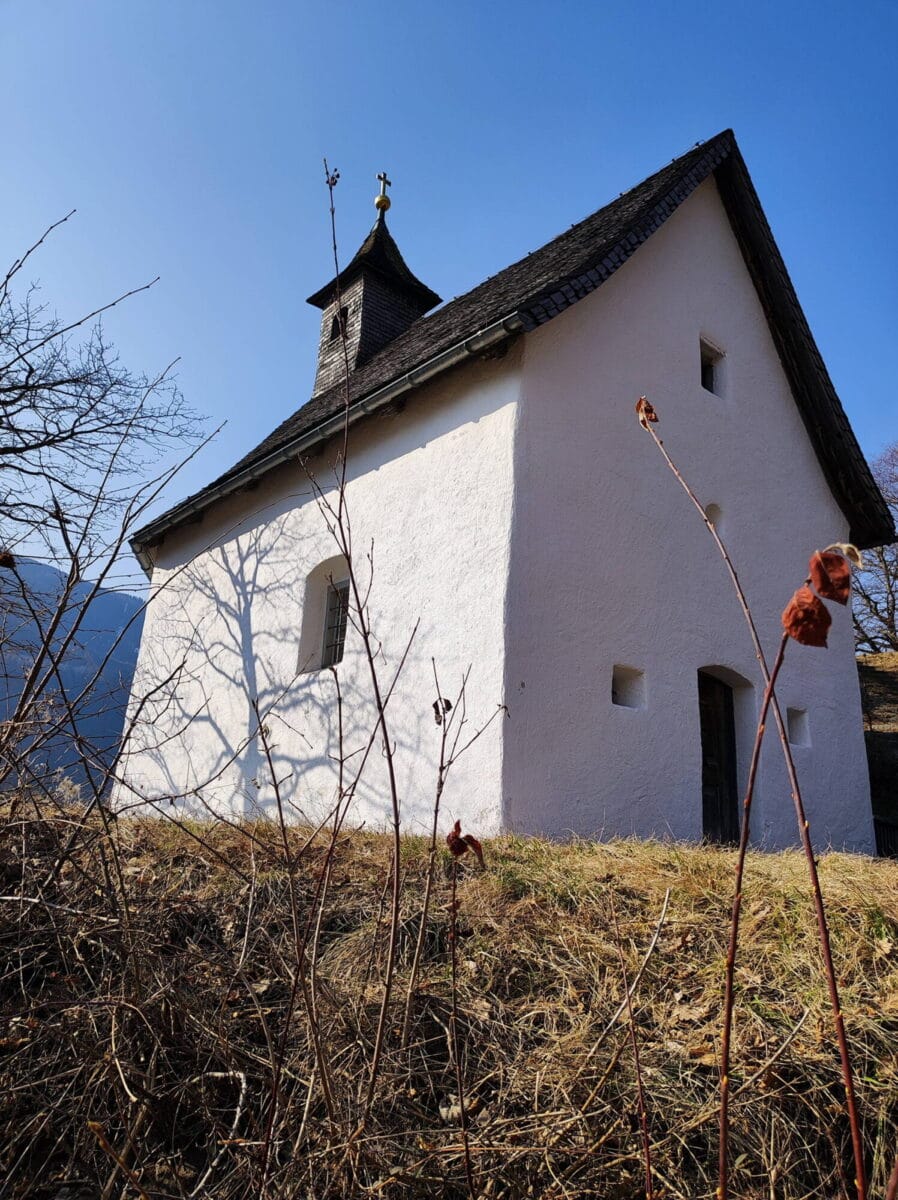
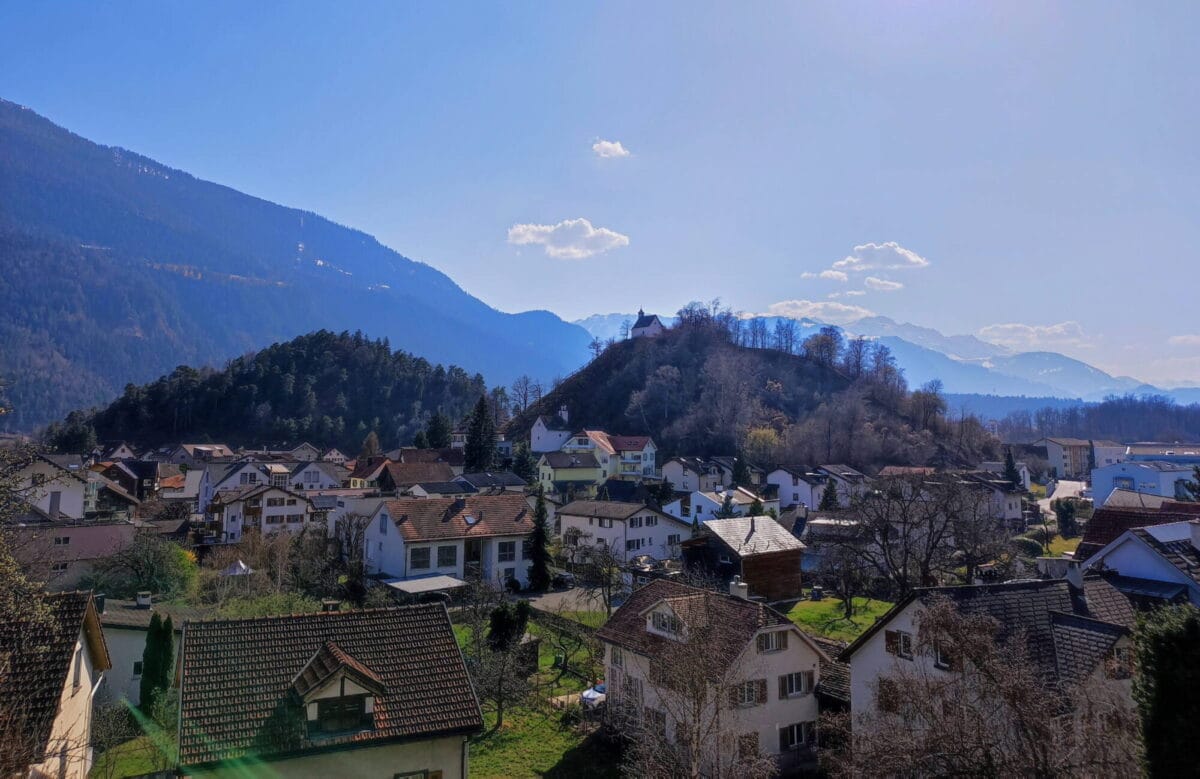
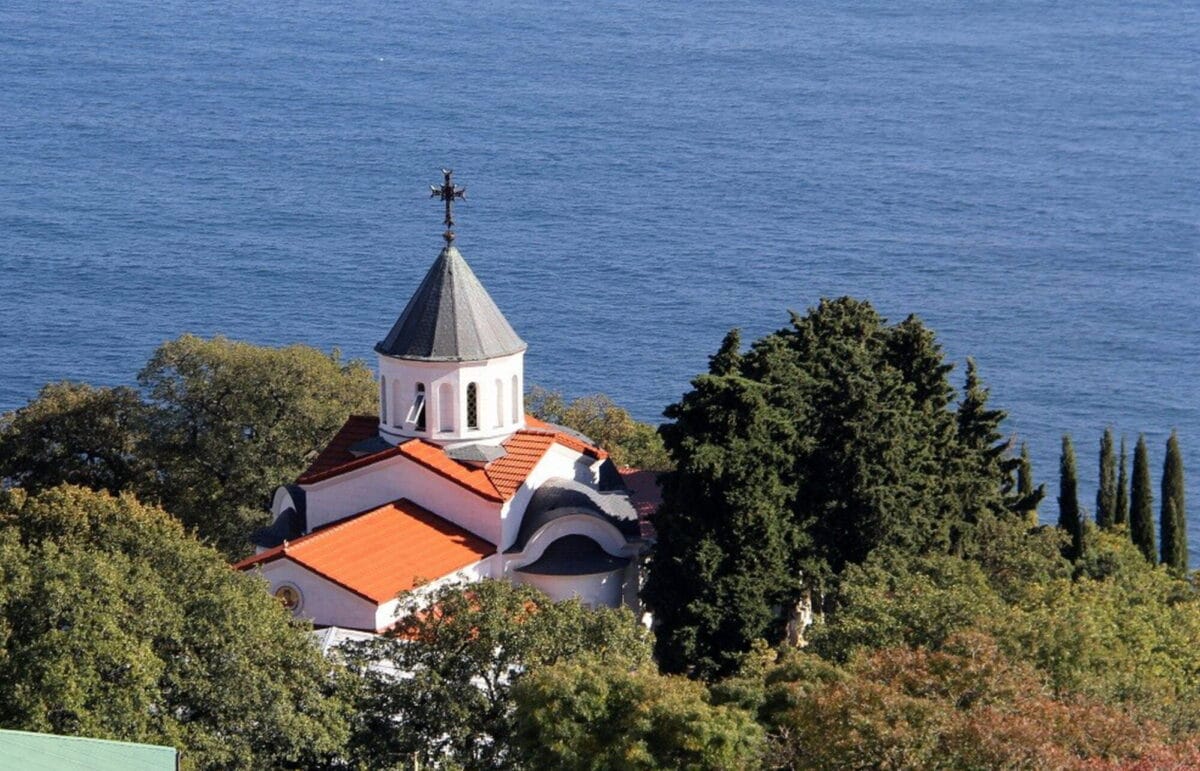
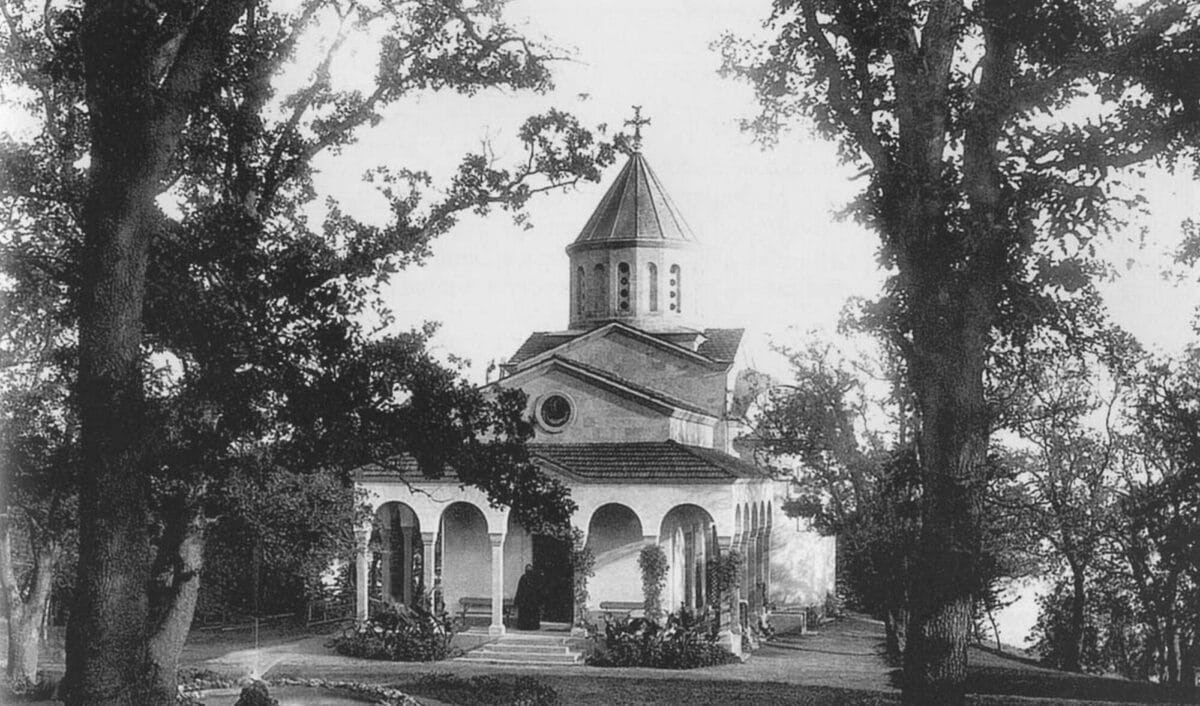
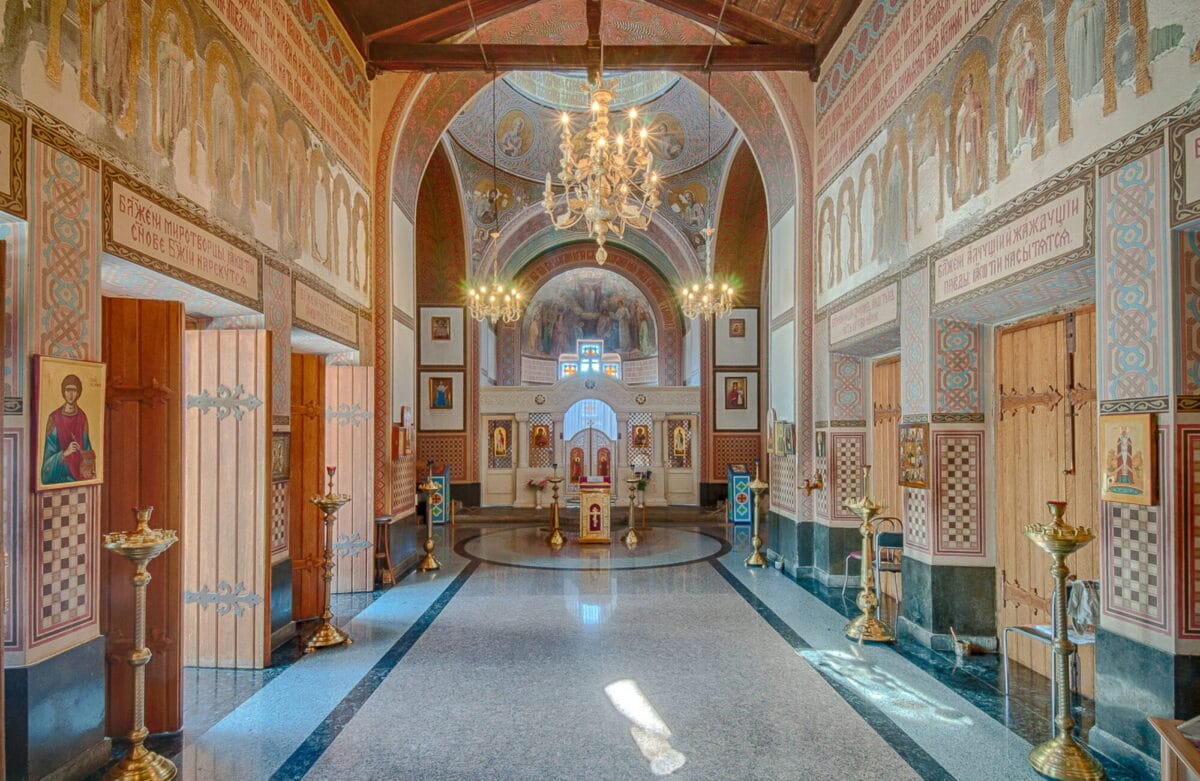
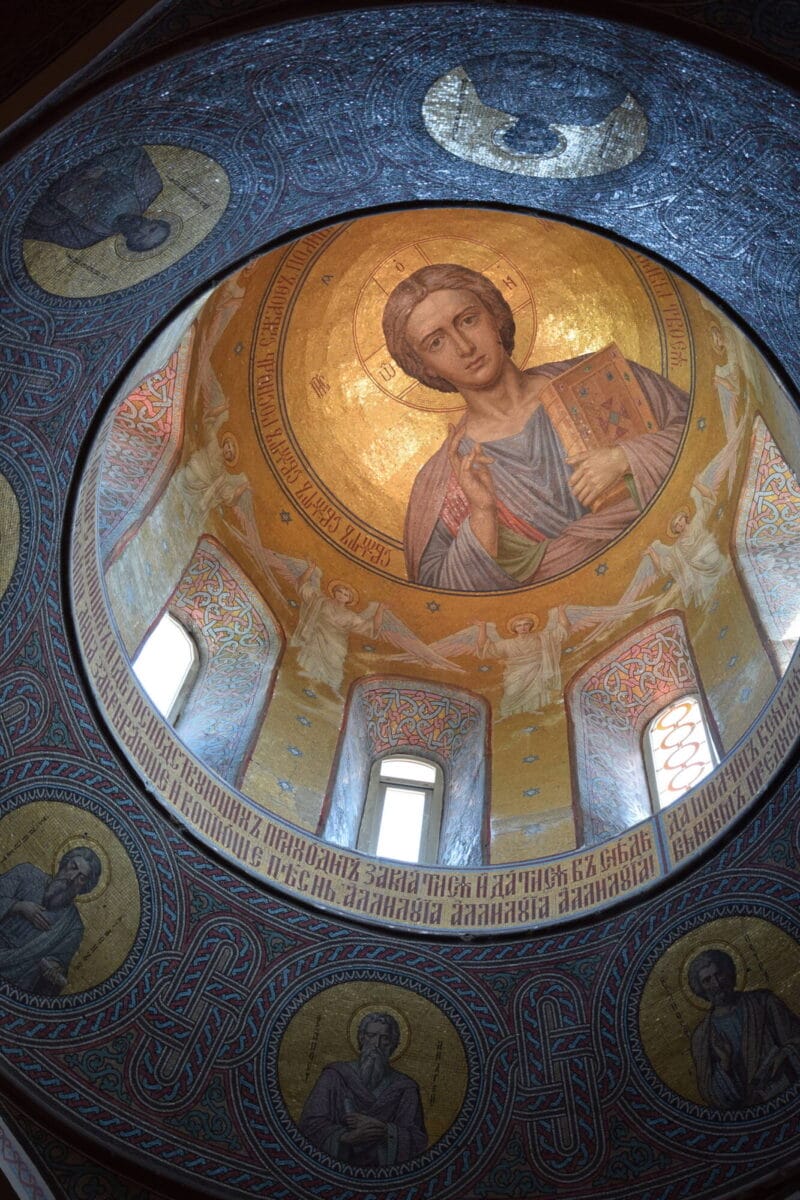
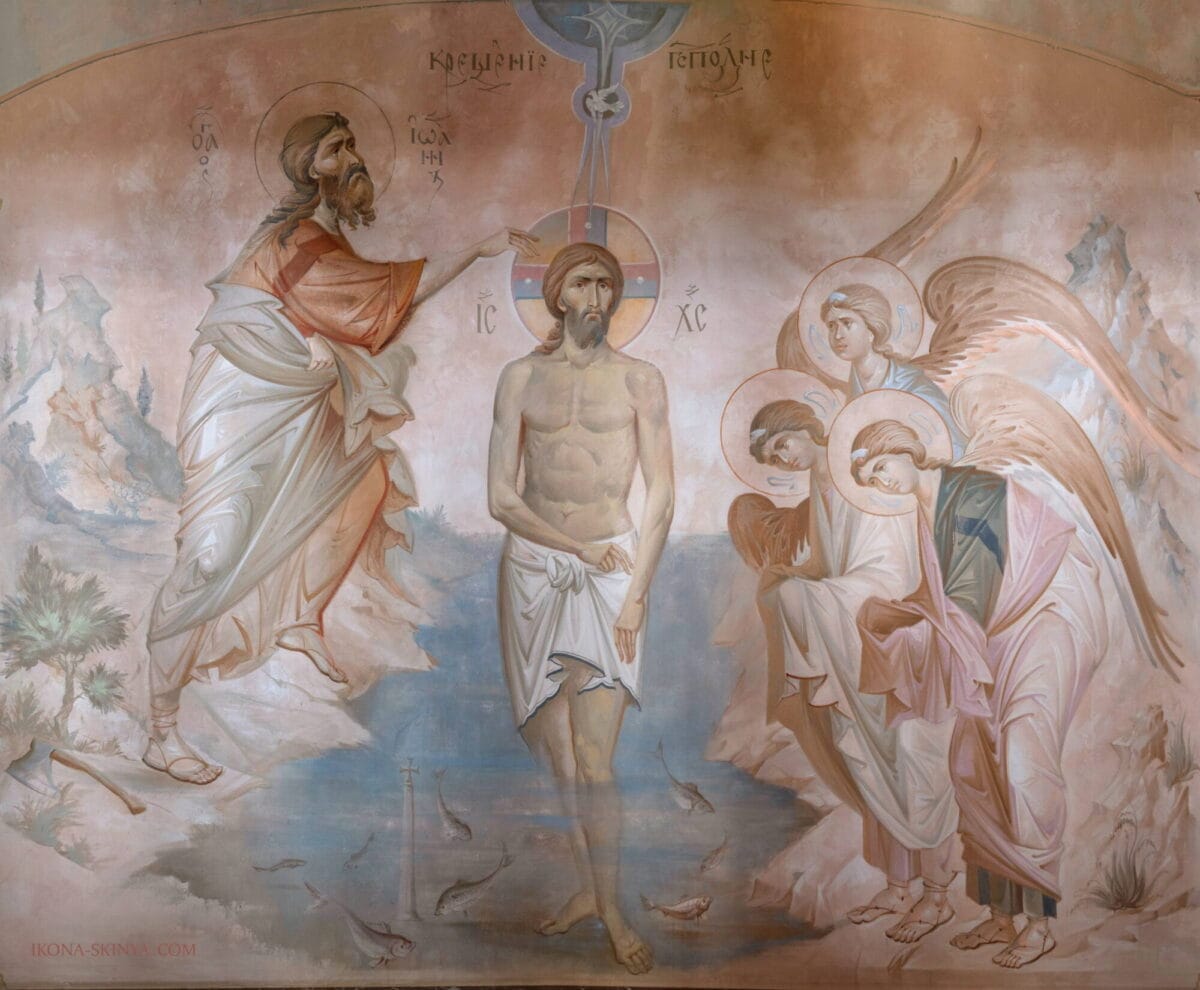
Great article, thank you. Brings to mind a quote from C.S. Lewis:
“It is so fatally easy to confuse an aesthetic appreciation of the spiritual life with the life itself…”
Simplicity and austerity are kindred to modesty and humility. Linking interiors to the outside lets His handiwork take center stage, rather than ours.
It would be good to learn what the authors feel could replace what “tradition” has bestowed upon us. Conservative Orthodox pundits enjoy using the vocabulary when describing Orthodoxy that are untranslatable into english and hence mean nothing to the reader. For icons and architecture, what would the authors propose? Icons of men doned with pants are few and far between. For women no such modification of wardrobe such as skits, blouses, etc. Some new church architecture has “see through” iconostasis which helps people relate. Domes and steeples are costly, most of them leak within a few years and yet this is “Orthodox” we proudly proclaim. What, dear authors, is the answer?
I think it is deliberate that Anton chose two wildly different churches as examples that he liked – a historic village church of typical local style, and a late-19th-century medieval-revival church designed by an academic and decorated with imported art. The origins of these churches could not be more different. However, both seem like a natural and appropriate expression of their place. The point is that with good design, even contemporary projects can achieve something like the organic beauty of historic churches. But there are no rules to follow. Every project is different. The enemy of good design is universal rules and conventions – which is exactly the pitfall that Anton observes in contemporary Russian liturgical art – everyone follows the same rules and styles, regardless of whether they’re a meaningful choice for the project at hand. Also, if you look at Anton’s own icons, you can see that he’s definitely not advocating modernized icons with men in pants, or anything like that.
Thank you Andrew! There is nothing to add to this
The article does not say a single word about “replacing” tradition with something. Here, on the Orthodox Arts Journal site, is an article I wrote several years ago – The Living Icon. In that article I tried to answer the question that was relevant at that time in Minsk and Moscow – should the Icon be modern (contemporary) or should it be traditional. The answer is the Icon should be both traditional and contemporary at the same time. If we remove traditionality from this formula, we will only get the artist’s fantasies. If we remove contemporality, we will get an empty form, devoid of content. How and in what proportion should we combine these two qualities? There is no ready answer, and perhaps there cannot be one. Each church artist or architect can find an answer only practically and only individually, based on their spiritual experience and their practical experience. That this is possible, we can see in numerous examples – I give some of them in the article. This concerns not only historical churches and icons, but also contemporary ones – thank God, they exist – but this is a topic for a separate large article and a serious conversation.
“If the parish consists of visually impaired and tone-deaf people, the task is simple. But if it is not so, those who form the appearance of the Orthodox Temple have a great responsibility.”
I greatly appreciate Daineko’s spiritual aesthetic insight and keen discernment of the boundaries between “organicity” and “fake.” Without this gift and the influence to adjudicate, new temples planned or in process risk the temptation of erecting disposable hybrids of Hogwarts Castle and Motel 6.
As a Catholic, this article raises a lot of red flags for me. It echoes precisely the rhetoric of so many Catholic reformers in the 1930s to the 1960s who, precisely in the name of being in step with and to express their times (and not the past), and in the name of doing away with kitsch and mass-produced devotional art, presided over the almost total destruction of Catholic sacred art and music in the 1960s to the 1980s.
Given that the Russians have built thousands of churches in the last 40 years or so, naturally there will be a lot of mass-production, kitsch, wrong decisions. But then the author displays a disturbing tendency I’ve noticed with some Russians: an extreme dreaminess combined with an extreme impatience with what they perceive as “bad”. It is as if he’d rather all of that were destroyed.
Be careful what you wish for. Unfortunately, my impression of many “intellectual” Orthodox is that you have little appreciation for the treasures (warts and all) you actually have, and are more than willing to repeat the experiment of Vatican II.
That’s a fair warning. I think Anton observes a real problem in modern Russian church art, but an ideological solution like the virtue-signaling Modernism of Vatican-II is definitely not the answer. And there are already enough examples of Russian churches flirting with Modernism to see that it’s usually a disaster. On the other hand, some of their experiments with proto-modern styles like Russian-Art-Nouveau have been really beautiful and successful. In any case, you can see from Anton’s own work that he’s no Modernist. He’s advocating for a sensitive awareness of place – which is all well and good. But the risk you mention is well-taken, because “sensitivity to place” is constantly used by Modernist architects to justify their ugly buildings. Proceed with caution indeed.
The Vatican-II is not a problem; it was an attempt to respond to an existing problem. This answer cannot be called successful, but this does not mean that the problem does not exist and does not need to be solved. The problem of the Church’s connection with real life arose for the Vatican in the last century, for the Russian Church it is already beginning to rise to its full height, for the American Church it will arise in the foreseeable future. What awaits the Christian community if it decides to close in on itself can be seen in the example of Russian Old Believers – today their community resembles more of a museum or a kind of reservation and will soon remain only as a memory. This is an example of an attempt to preserve tradition at all costs – tradition for the sake of tradition. We are lucky – we have two negative examples and can make decisions prudently. I think there is no ready-made recipe for how to walk the middle path between the Vatican-II and the Old Believer Church.
In terms of Church Aesthetics, there are several steps that can be taken in this direction. The rector, understanding the issues facing him, can try to find professionals who are familiar with these issues and are ready to look for a solution. Artists and architects can approach this process responsibly, remembering that each temple is unique, and each icon is a Revelation. If, due to fear of Modernism, the rector and the artist decide that it is better to do nothing at all, this will be the wrong step.
The article has a good point about the difference between the “community driven” versus “rich donor driven” in getting the “end result,” which in any case is – a local church. The result will be totally different, as it is the case when the parish considers the priest their employee. It will be just lukewarm imitation of a corporation with a board and a CEO/Priest. If a faithful community builds the church it is going to reflect their soul like a soulmate. The rich donors, rarely will not be humble, and also posses artistic sensibility. They make the most difficult clients for the architect and the builder. Also, if a construction of a church leads to a split in the parish with some of the faithful people leaving for another church, that tells a lot about the “end result.’
Now, on the “momentum” in entering a church, mainly is because of a “pattern language,” as it is well described in Christopher Alexander’s book. It is hard to find a new visual expression better than all has been tested in the last 2,000 years. The lack of resources and the fear of potential destruction, resulted to very simple, and in the same time, beautiful churches. The best example are all the pre-gothic churches in France, the wood churches of Russia, churches of Moldavia with exterior frescoes, s.o. The captioned the sense of sacred space and not being a sort of museum. A museum is never a sacred space, just a display of curious productions of dead artists.
Dear Anton, congratulations! Once again you have spoken vital truths as a gardener of the Church’s beauty. I wish this article and the comments section above would be required reading for clergy and building committee members.
Thank you, Baker!
About reading for clergy and building committee members – I absolutely agree – Orthodox Arts Journal should be a mandatory option.